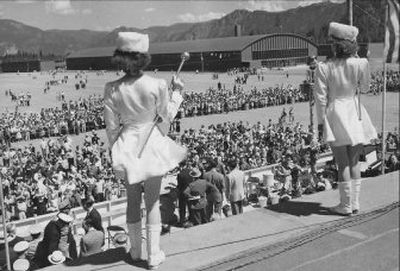Historical Farragut

For a couple of years, it was the largest “city” in Idaho with 700 to 800 buildings. It was built for a population of 45,000 and eventually was the transient home of some 300,000.
All that remains now, 60 years after its heyday, is a single building and a water tower.
It was the Farragut Naval Training Station, 30 miles north of Coeur d’Alene which, during World War II, was the second-largest naval training base in the world.
Local historian Robert Singletary described the brief life of the facility during a recent evening lecture at North Idaho College to an audience of about 50, including two men who took boot training there, another who was confined in its 1,500-bed hospital, and a woman who was born on the base.
Singletary was dressed in a uniform approximating that of the principal Farragut base commander, Commodore Frank H. Kelly.
The historian said Kelly was a 1910 graduate of the U.S. Naval Academy and had many ship and shore assignments prior to taking over the training center in May 1943. Virtually nothing is known of his life following the decommissioning of the base in 1946, and Singletary would like anyone who can shed light on the man to contact him at NIC.
According to Singletary, the Navy had only three training facilities at the time of the attack on Pearl Harbor. Realizing that there would be a need for many thousands of seamen to man its ships and shore installations, the department decided to build new installations in the eastern and western U.S.
For the western base, officials settled on a site at the southern end of Lake Pend Oreille. They selected this inland location out of fear that an installation closer to the coast might invite Japanese bombs.
On April 10, 1942, a $58 million construction contract was awarded to the Walter Butler Co., of St. Paul, Minn., and ground was broken 13 days later. About 2,000 men were put to work falling trees, clearing brush, building roads and laying in a spur railroad line from Athol to the 4,000-acre site.
On May 30, President Franklin Roosevelt named the station in honor of Adm. David Glasgow Farragut, the first admiral in the U.S. Navy.
By the first of June, 7,000 workers were on site, using green lumber cut there to construct buildings, and the first camp was dedicated and turned over to the Navy on Aug. 2.
The master of ceremonies for that dedication ceremony was Hollywood actor Dick Powell; one of the entertainers was Western film actress and singer Dale Evans, and newsman Chet Huntley described the proceedings for a CBS radio audience. Some 30,000 tickets were sold at $1.50 each, and the proceeds were donated to the Navy Relief Fund.
Seven camps – Bennion, Ward, Waldron, Hill, Scott, Peterson and Gillmore – each named for a Navy hero who’d been killed in action, were eventually built on the Farragut site, which was personally inspected by President Roosevelt in the fall of 1942.
Each camp had a capacity of 5,000 men and was laid out in an oval. They all included a 14-acre drill field, 22 two-story barracks, a mess hall, drill hall, recreation building, two medical dispensaries, laundry building and rifle range. The mess halls could feed the 5,000 people in 90 minutes.
The recreation buildings included a library, bowling alley, game room with pool and ping-pong tables, soda fountain, merchandise area and two barbershops. Inside the drill halls were six basketball courts, a boxing ring and a 50-by-75-foot swimming pool.
Singletary said those pools were used in the training program. The “boots” were required to dive from a platform and swim 50 yards before graduation, and 30 to 50 percent had to be taught to swim.
Each camp also had a headquarters building and living quarters for officers assigned to the training cadre.
In addition to the self-contained camps, other structures on Farragut included a central administration building, receiving and outgoing stations, a 20,000-seat football stadium, heating plants, shops, warehouses, chapels, a brig and – a member of the audience reminded Singletary – Farragut Village, which housed families of some assigned personnel.
Toward the end of the war, about 1,000 Germans and a few Italians were housed in a prisoner-of-war camp on the Farragut site.
The camp was decommissioned in the summer of 1946 and, for two years after, some of the buildings were used by a school which was established there, the Farragut College and Technical Institute. The college closed in 1948, and the remaining buildings and equipment were sold.
The Idaho Department of Parks and Recreation assumed control of the area in 1966, establishing Farragut State Park.
The Naval Sea Systems Command retains a small part of the former base for an underwater acoustical research facility. However, the only building remaining from its boot camp days is the brig, which now is a museum housing photos, flags and other memorabilia of Farragut’s days as the biggest city in Idaho.